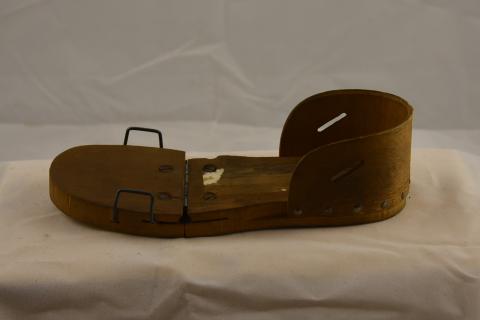Substitute children's shoe from wartime Germany. Made of wood with metal hinges and screws. The heel is ovular-shaped, with a curved piece of thin wood on the back to provide housing for the back of a foot. There is a hinge located halfway along the heel, indicating that the show could flex up and down while walking. Two hooks attached to the front of the shoe likely served to house a leather strap that no longer remains with the shoe. During World War I, much of the German economy was reallocated to service the production of munitions and other materiel for the war effort. Economic conditions were worsened with the years-long British blockade of the North Sea passages, which effectively cut off countries like Germany, Denmark, Sweden, and Norway from vital trading routes to the Atlantic. As the blockade continued, economic tensions became worse and more widespread in German cities. The vast expenditure of the German national gross product on munitions helped to weaken the country's economy, precipitating the devastating economic crisis of the Weimar Republic in the 1920s. It is likely that this shoe was created when leather became a rationed product in Germany. This content can be used with the following resources: SS-Econ.9-12.24: Iowa Economy Impact Upon This content can be used to educate students on the economic impacts that global conflicts have historically had on peoples around the world, even in the Midwest. By comparing this piece to pieces from America at the same time, students can see the comparisons between how the First World War affected civilians both in Germany and in Iowa. For any use other than instructional resources, please check with the organization that owns this item for any copyright restrictions.
2018.002.042 [Shoe]
Legal Status
Copyright to this resource is held by the Iowa Masonic Library and Museum and has been provided here for educational purposes only, specifically for use in the Iowa Museum Association's "Teaching Iowa History" project. It may not be downloaded, reproduced or distributed in any format without written permission from the Rights Holder. For more information on U.S. and International copyright laws, consult an attorney.

